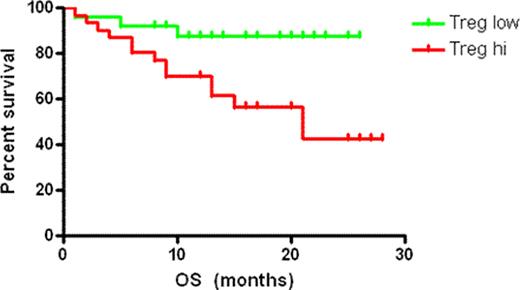Abstract
Abstract 984
Multiple myeloma (MM) is a immunoproliferative disease which is characterized by the uncontrolled proliferation of plasma cells which is accompanied by defects in the immune system. Abnormalities of function and number of T regulatory cells (Treg), dendritic cells (DC) might be responsible for the immunosuppression in MM. DC and Treg are the most important cells in the immune system, able to control peripheral tolerance as well as response to foreign and tumor antigens. The current study aimed to characterize the frequency of Treg, DC as well as subpopulations of T cells bearing regulatory properties like CD4+GITR+, CD4+CD62L+, CD3+TCRγδ+ along with the concentration of IL-10, TGFβ, IL-6 in patients with MM. Subsequently the influence of therapy on those components of immune system was assessed.
The study population consisted of 66 newly diagnosed MM patients (females-29, males-37, median age 66.5 years; range 39–81) admitted to the Department of Hematoonocology Medical University of Lublin. The study was approved by the Local Ethics Committee. Immune cells subpopulations were evaluated by the flow cytometry. Myeloid DC (MDC) were identified as blood dendritic cell antigen-1 (BDCA-1) positive and CD19 negative cells. Plasmacytoid DC (PDC) were characterized as blood dendritic cell antigen-1 (BDCA-2) and CD123 positive cells. We also estimated the frequency of Treg (CD4+CD25hiFOXP3+) and other populations of lymphocytes with regulatory function such as: CD4+GITR+, CD4+CD62L+, CD3+TCRγδ+. We used enzyme linked (ELISA) assay to detect cytokines IL-10, IL-6, TGFβ in serum of MM patients.
In the current study we observed that the percentage of both MDC and PDC was lower in MM compared to control group (0.16% vs. 0.19% and 0.03% vs. 0.12%, respectively). The frequency of Treg was significantly higher in MM patients compared to healthy control (6.16% vs 0.05%). Also, the percentages of CD4+GITR+, CD4+CD62L+ were increased compared to healthy volunteers (95.19% vs 78% and 10.35% vs 0.42%, respectively). The frequency of CD3+TCRγδ+ was lower compared to control group (2.82% vs 6.05%). We further assessed the influence of certain immune cells frequencies on clinical behavior of MM patients. We found that patients with higher percentages of Treg live shorter (median survival 21 months vs not-reached, p=0.013, Figure 1). Serum levels of cytokines IL-10, IL-6, TGFβ were increased in MM compared to control group (1.16pg/mL vs 0.91pg/mL for IL-10; 3.74pg/mL vs 2.12pg/mL for IL-6; 32233.5pg/mL vs 3877.23pg/mL for TGFβ). During therapy we detected significant lowering concentration of IL-10, to higher extent in responders.
In conclusion our results identified several abnormalities of immune system in MM. The dysfunction of immune system (decreased antigen presentation along with increased frequencies of suppressive cells and cytokines) might facilitate progression of the disease and infectious complications. The most important finding of our study is the key function of Treg in modulation of overall survival of MM patients.
Overall survival by low (Treg low – below the median) and high (Treg hi – above the median) T regulatory cells frequencies of multiple myeloma patients.
No relevant conflicts of interest to declare.
Author notes
Asterisk with author names denotes non-ASH members.


This feature is available to Subscribers Only
Sign In or Create an Account Close Modal